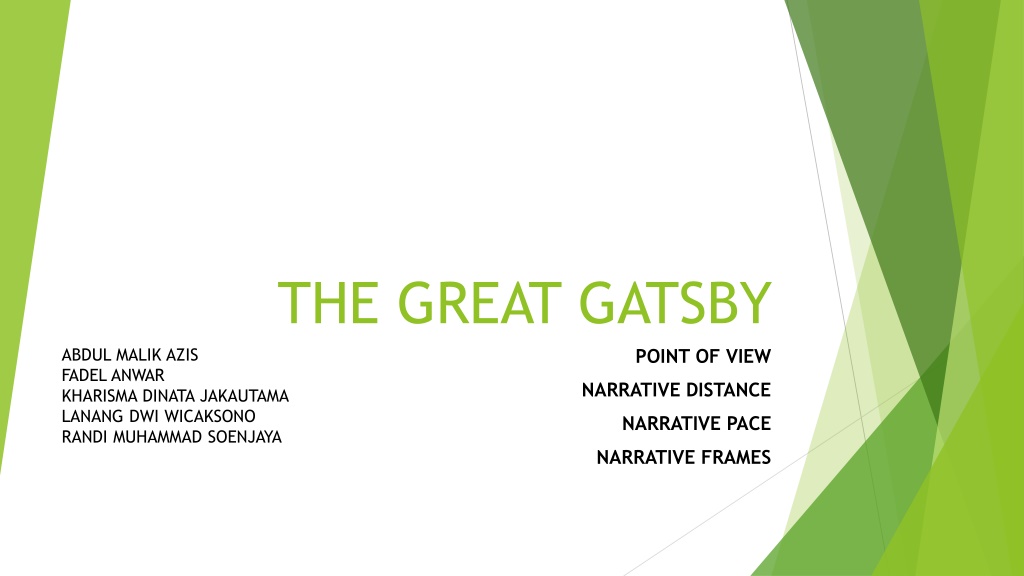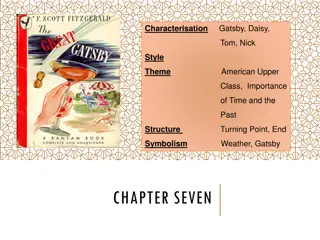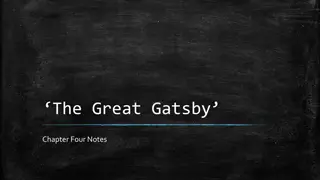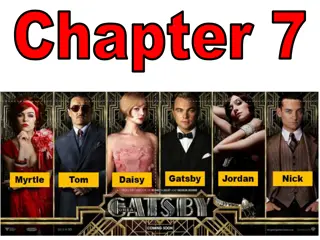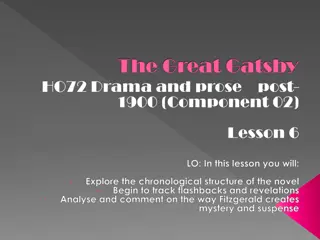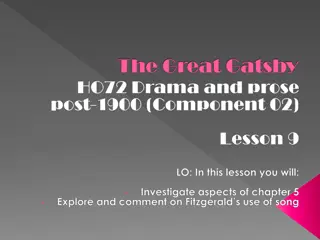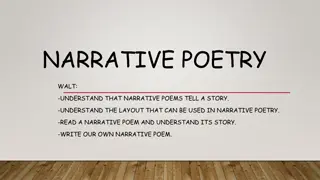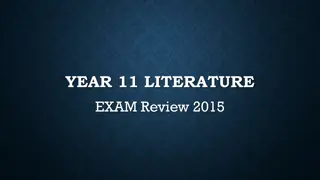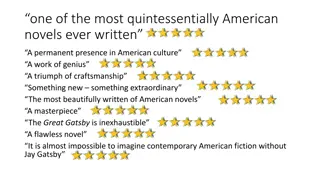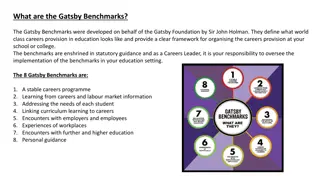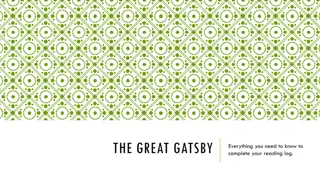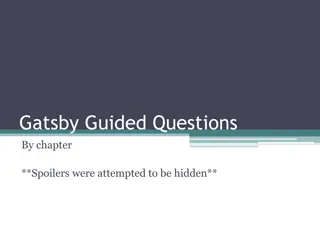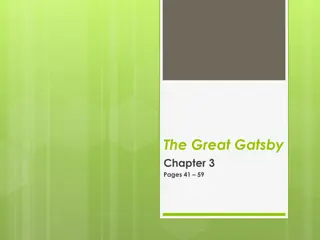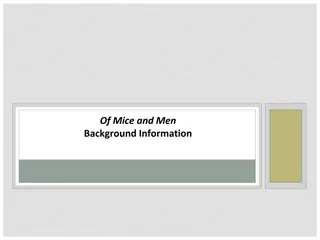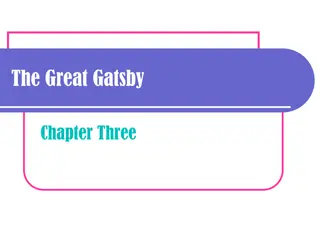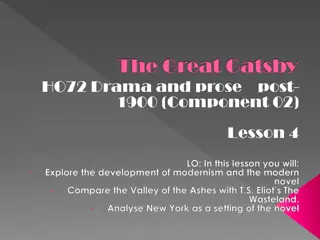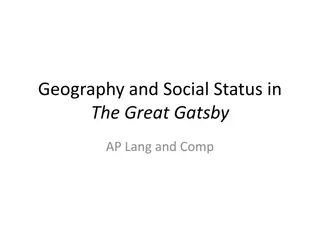Understanding Narrative Elements in "The Great Gatsby
Explore the narrative elements in "The Great Gatsby" such as point of view, narrative distance, and narrative pace. The novel is analyzed from chapters 5 to 9, focusing on Nick Carraway's first-person perspective and the small narrative distance, which adds realism to the story.
Download Presentation

Please find below an Image/Link to download the presentation.
The content on the website is provided AS IS for your information and personal use only. It may not be sold, licensed, or shared on other websites without obtaining consent from the author. Download presentation by click this link. If you encounter any issues during the download, it is possible that the publisher has removed the file from their server.
E N D
Presentation Transcript
THE GREAT GATSBY ABDUL MALIK AZIS FADEL ANWAR KHARISMA DINATA JAKAUTAMA LANANG DWI WICAKSONO RANDI MUHAMMAD SOENJAYA POINT OF VIEW NARRATIVE DISTANCE NARRATIVE PACE NARRATIVE FRAMES
POINT OF VIEW Point of view is the angle of considering things, which shows us the opinion or feelings of the individuals involved in a situation. In literature, point of view is the mode of narration that an author employs to let the readers hear and see what takes place in a story, poem or essay. The types of point of view: -First Person -Third Person
THE GREAT GATSBY : POINT OF VIEW The Great Gatsby is written in first-person limited perspective from Nick s point of view. This means that Nick uses the word I and describes events as he experienced them. He does not know what other characters are thinking unless they tell him. Although Nick narrates the book, in many ways he is incidental to the events involved, except that he facilitates the meeting of Daisy and Gatsby. For the most part, he remains an observer of the events around him, disappearing into the background when it comes time to narrate crucial meetings between Gatsby, Tom, and Daisy.
NARRATIVE DISTANCE The term narrative distance describes the proximity of the story s narrator to the subject he is describing. In other words, narrative distance is the distance between the narrator and other elements of fictional world, such as the story s characters, setting, and events. Narrative distance ranges from small to large.
THE GREAT GATSBY : NARRATIVE DISTANCE In our opinion, the narrative distance range on The Great Gatsby novel which we analyzed from chapter 5 until chapter 9 is small. Because Nick Carraway, the narrator of The Great Gatsby which also act as the witness in its story didn t tell about The Great Gatsby as plain, but he told about his thoughts and perceptions color and shape the story. And exactly, The Great Gatsby functions as a personal memoir of Carraway s experiences with his mysterious neighbor, Jay Gatsby in the summer of 1922. The story becomes more realistic by means of using an first- person-narrator. Because Nick Carraway is experiencing events and telling the reader about them in his own words, the plot becomes more believable.
NARRATIVE PACE Narrative pace determines how quickly or how slowly the writer takes a reader through a story. It relies on the combination of mood and emotion as these elements play out in the dialogue, setting and action. There are some pacing elements: Action An action scene dramatizes the significant events of the story and shows what happens in a story. Cliffhanger When the end of a chapter or scene is left hanging, naturally the pace picks up, because readers would turn the pages to see what happens next. Dialogue A rapid fire dialogue with lesser or irrelevant information is captivating, swift and invigorates scenes. Word Choice The language itself is a means of pacing, like using concrete words, active voice, and sensory information.
THE GREAT GATSBY : NARRATIVE PACE After we analyze about the Narrative pace that based on The Great Gatsby story, we think from chapter 5 until chapter 9, even in the beginning too, showed the slowly pacing if we see from how Nick told The Great Gatsby story, which he told more details in every action, scene and dialogues.
NARRATIVE FRAME Frame story is a story set within a story, narrative, or movie, told by the main or the supporting character. A character starts telling a story to other characters, or he sits down to write a story, telling the details to the audience. This technique is also called a frame narrative, and is a very popular form of literary technique employed in storytelling and narration. Frame story usually is found in novels, plays, poems, television, films, musicals, and opera. It is a unifying tale within which one or more related stories appear. For instance, in Homer s Odyssey, Odysseus tells about his wandering experience in the court of King Alcinous, or his visit to the island of a sorcerer.
NARRATIVE FRAME : THE GREAT GATSBY F. Scott Fitzgerald employs a frame story in The Great Gatsby in order to expand the distance between the events of the plot and the readers. This distance creates uncertainty in the reliability of the events portrayed through Nick Carraway, thus characterizing Jay Gatsby with a heightened sense of mysticism. The Great Gatsby is essentially set up as a frame narrative. Nick Carraway, the narrator, is telling the story of Gatsby. Nick is the protagonist in his communication with the East, and his disappointment with the American dream of success. Gatsby is the main character in Nick's story which makes the Great Gatsby a frame narrative. Gatsby is the protagonist of his own battle to achieve the American dream, which he personifies in Daisy.
The impact of the frame narrative on the story is massive. This is due to the way that it takes effect upon the reader. The frame narrative allows the reader to uncover events that would be significantly harder to understand without it. For example, we can infer that Gatsby and Daisy have loved each other for a significant amount of time, and Daisy had moved on in anticipation for Gatsby by marrying Tom. "And what's more, I love Daisy too? This quotation is taken from Nicks frame narrative which uncovers vital information for the reader. Nicks story is revered as it crops up in every chapter of the story. Regardless of what has happened in the chapters, the story will always take a pause from its main plot, giving Nick his chance to explain to the reader his point of view. This is Fitzgerald?s way of shortening the story whilst keeping Nicks point of view in contention.
